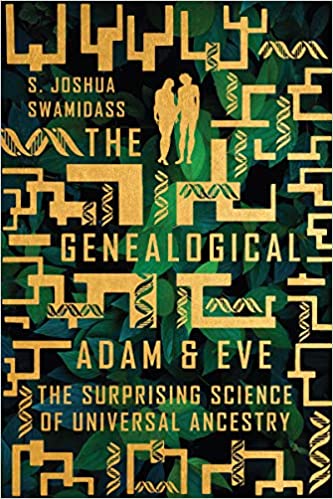Having first read William Lane Craig’s fascinating book on the The Quest for the Historical Adam, that book kept mentioning a computational geneticist named Joshua Swamidass as a dialogue partner. I decided I’d better read his book as well about a genealogical Adam and Eve. Let me say right off the bat as a Biblical scholar that both books are excellent, and both, in my view, have some significant exegetical deficiencies which is not entirely surprising since Craig is a philosopher, and Swamidass a scientist. In regard to the ethos of each book, Craig is more definitive and certain about his conclusions, and Swamidass more open to a variety of possibilities though he takes a definite position on the genealogical as opposed to the genetic ancestry we all have, in particular in regard to Adam and Eve. Both books affirm that yes there was an historical Adam, with Craig thinking it must have been hundreds of thousands of years ago, and Swamidass showing that it could have been much more recently, say 6 to 12,000 thousand years ago. Let me first share the statement on Amazon crafted I presume by IVP about Swamidass’ book—
“Evolutionary science teaches that humans arose as a population, sharing common ancestors with other animals. Most readers of the book of Genesis in the past understood all humans descended from Adam and Eve, a couple specially created by God. These two teachings seem contradictory, but is that necessarily so? In the fractured conversation of human origins, can new insight guide us to solid ground in both science and theology? In The Genealogical Adam and Eve, S. Joshua Swamidass tests a scientific hypothesis: What if the traditional account is somehow true, with the origins of Adam and Eve taking place alongside evolution? Building on well-established but overlooked science, Swamidass explains how it’s possible for Adam and Eve to be rightly identified as the ancestors of everyone. His analysis opens up new possibilities for understanding Adam and Eve, consistent both with current scientific consensus and with traditional readings of Scripture. These new possibilities open a conversation about what it means to be human. In this book, Swamidass:
- untangles several misunderstandings about the words human and ancestry, in both science and theology
- explains how genetic and genealogical ancestry are different, and how universal genealogical ancestry creates a new opportunity for rapprochement
- explores implications of genealogical ancestry for the theology of the image of God, the fall, and people “outside the garden”
Some think Adam and Eve are a myth. Some think evolution is a myth. Either way, the best available science opens up space to engage larger questions together. In this bold exploration, Swamidass charts a new way forward for peace between mainstream science and the Christian faith.”
That is a good summary of the book, and throughout the tone is irenic and friendly and various options of interpretation are fairly aired. Perhaps the most important point the book makes is that there is a difference between genetic ancestry and genealogical ancestry, and that in assessing Adam and Eve it is the latter which needs to be focused on, not the former. This being the case, a book like Adam and the Genome previously discussed on this blog, is likely barking up the wrong tree, and comes to the wrong conclusions. I will not spoil the fine way Swamidass carefully lays out his evidence for the difference between these two things, but the main thing to observe is that he definitely shows that all human beings by the period A.D.1 to A.D. 30 could indeed be the descendants of Adam and Eve, provided there was interbreeding between those who were outside of the garden of Eden (namely Cain and Seth) and those who already existed outside the garden of Eden.
There are two other points he necessarily makes to support this conclusion: 1) the genetic evidence of all of humanity sharing a common ancestor with apes is real and evolution should not be denied its place in our considerations (something Craig and Swamidass agree on), and 2) none of that evidence in any way denies or refutes that God could have also created de novo Adam and Eve as well. In short, Swamidass argues evolution of humans outside Eden, supernatural creation of Adam and Eve inside Eden. He makes an excellent case, pointing out that with interbreeding between Adam and Eve’s progeny and those outside the garden, something Genesis itself suggests, by the time we get to Jesus’ day human beings all provide genetic evidence of a long evolution and sharing a common ancestor with the higher primates but also genealogical evidence that the human race comes from Adam of Eve. There is no slight of hand or pulling a rabbit out of a hat in this argument. The real strength of Swamidass’ book is his careful scientific discussion about genetics and genealogy, laying out the evidence in detail.
There are however some exegetical weaknesses, but none of them are fatal to his case. The first I will point out is that Gen. 2-3 not only mentions Adam and Eve’s sin, but God’s curse on both humans and creation itself in response to the sin. You cannot talk about the Fall just in terms of human sin. As Paul later says in Rom. 8– the whole of creation was subjected (by God) to futility and is groaning for release. This was caused by the curse, not in the first instance by human sin, though every human sin has continued to mar, misuse, and even destroy parts of creation and many creatures along the way. Secondly, the other part of the curse falls not just on the labor pains of Adam dealing with the soil, but also the labor pains of Eve both in the danger of bearing children but also ‘your desire will be for your husband and he will lord it over you’ (cf. the LXX translation of this key verse and its use of kyrios). Patriarchy then is a result of not just the Fall but of God’s judgment on humanity as a result of sin. To love and to cherish degenerates into to desire and to dominate. And Swamidass is right to emphasize that nothing at all in Gen. 1-3 talks about human beings dominating or even destroying other human beings using violence and war. The creation mandate was to fill the earth and subdue it— not subdue or subordinate or destroy other human beings.
One more thing. The Gen. 2 creation story does indeed say Eve was created because of the deficiencies in Adam— he needed a suitable partner to be able to fulfill the creation order mandate and ‘it was not good for man to be alone’. Nothing in that account suggests the necessary subordination of women to men, or wives to husbands. The word ‘helper’ here is also used of God himself in the OT as the helper of Israel and certainly does not necessarily imply the subordination of Yahweh to Israel!! The old King James’ ‘a help meet’ that is a suitable helper is an appropriate translation. The subordinate of wives and woman comes as a result of the judgment on Adam and Eve’s sin— your desire will be for your husband and he will rule/lord it over you. This is in no way the original blessing or the original creation order plan that is enunciated in Gen. 1-2—male and female he created them in his image and after his likeness.
Swamidass does no detailed exegesis of Gen. 1-2 paying attention to the particulars of the Hebrew. Another place where this causes some issues is in regard to the tree of life. There really is no reason to think that mortality was the punishment for human sin. The tree of life in the garden strongly suggests that positive immortality was within the grasp of Adam and Eve and they could have eaten of that tree, but alas chose the tree of the knowledge of good and evil. The death they experienced was spiritual death, and this is the death Paul later says came to us from Adam as a result of the first sins. You can see the evidence of this spiritual death in the ‘heart turned in upon itself’— Adam and Eve become narcissists, self-conscious about even their lack of clothing and afraid of the God who made them— in short very self-centered and self- protective, hiding from God. They did not physically die after eating the fruit. Indeed, they lived a good long time thereafter. Probably one reason Adam and Eve are cast out of the garden is so they won’t eat of the tree life, and be everlasting fallen creatures who cannot die (much like the famous story in Swift’s Gulliver’s Travels of the man who asked for everlasting life but not everlasting youth… and so he kept getting older without the ability to die).
In any case, these sorts of exegetical possibilities are not pursued in Swamidass’ book. He is however right that the ethos and social setting of the story in Gen. 2-3 favors the conclusion that we are not talking about what Craig insists on— Adam and Eve living hundreds of thousands of years before agriculture or tools or religious sacrifices show up on earth. Swamidass shows this conclusion is not necessary either scientifically or historically. We will probe more about this in our dialogue with Swamidass which follows this post.
One last thing to ponder which Swamidass points out— if we don’t have a problem with the virginal conception of Jesus in the womb of Mary as a miracle, which is clearly a de novo sort of creation, we should have no problems with a de novo miraculous creation of Adam and Eve in the garden. He is right about this. Consider me convinced by the scientific part of Swamidass’ arguments. In short, we don’t need a young earth theology, we don’t need an anti-evolution polemic, and we don’t need an Adam that was like Heidelberg man. Rather Adam and Eve showed up hundreds and thousands of year later than such humanoids or homo sapiens, or whatever you want to call them. Also, we don’t need to deny that the people outside the garden were created in God’s image just as Adam and Eve were. Indeed, I would say that Genesis 1 is the universal account about the creation of all human beings, and Gen. 2 is more specifically the account of the creation of the direct ancestors of God’s people. After all, the Bible is overwhelmingly just the story of God’s people and salvation history, not primarily the story of everyone. More on this in the following posts.












